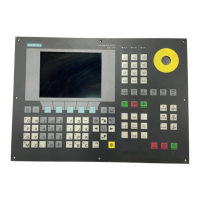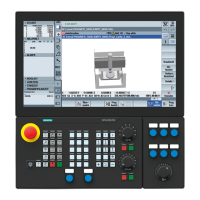K2: Axis Types, Coordinate Systems, Frames
10.5 Frames
Basic Functions
Function Manual, 09/2011, 6FC5397-0BP40-2BA0
753
The workpiece geometry is described by a coordinate system that is formed by the geometry axes. A channel
axis is assigned to each geometry axis and a machine axis is assigned to each channel axis. An axial frame
exists for each machine axis and for each frame (system frame, basic frame, settable frame, programmable
frame). When a new machine axis is assigned to a geometry axis, the axial frame components of the machine
axis, such as translations (coarse and fine), scales and mirrors of the appropriate frame, are also applied. The
new geometry in the channel is then generated by the new contour frames resulting from the new geometry axes
(up to three in number).
The current valid frames are calculated again on the geometry axis switchover and a resulting complete frame is
generated. The data management frames are not included unless they are activated.
Example:
The channel axis is to become a geometry axis x through geo axis substitution. The substitution is to give the
programmable frame a translation component of 10 in the x axis. The current settable frame is to be retained.
MD10602 $MN_FRAME_GEOAX_CHANGE_MODE = 1
Several channel axes can become geometry axes on a transformation change.
Example:
Channel axes 4, 5 and 6 become the geometry axes of a 5axis transformation. The geometry axes are thus all
substituted before the transformation. The current frames are changed when the transformation is activated. The
axial frame components of the channel axes, which become geometry axes, are taken into account when
calculating the new WCS. Rotations programmed before the transformation are retained. The old WCS is
restored when the transformation is deactivated. The most common application will be that the geometry axes do
not change before and after the transformation and that the frames are to stay as they were before the
transformation.
Machine data:
$P_UIFR[1] = CROT(x,10,y,20,z,30) ; Frame is retained after geo axis
substitution.
G54 ; Settable frame becomes active.
TRANS a10 ; Axial offset of a is also substituted.
GEOAX(1, a) ; a becomes x axis;
$P_ACTFRAME=CROT(x,10,
y,20,z,30):CTRANS(x10).
$MN_FRAME_GEOAX_CHANGE_MODE = 1
$MC_AXCONF_CHANAX_NAME_TAB[0] = "CAX"
$MC_AXCONF_CHANAX_NAME_TAB[1] = "CAY"
$MC_AXCONF_CHANAX_NAME_TAB[2] = "CAZ"
$MC_AXCONF_CHANAX_NAME_TAB[3] = "A"
$MC_AXCONF_CHANAX_NAME_TAB[4] = "B"
$MC_AXCONF_CHANAX_NAME_TAB[5] = "C"
$MC_AXCONF_GEOAX_ASSIGN_TAB[0] = 1
$MC_AXCONF_GEOAX_ASSIGN_TAB[1] = 2
$MC_AXCONF_GEOAX_ASSIGN_TAB[2] = 3

